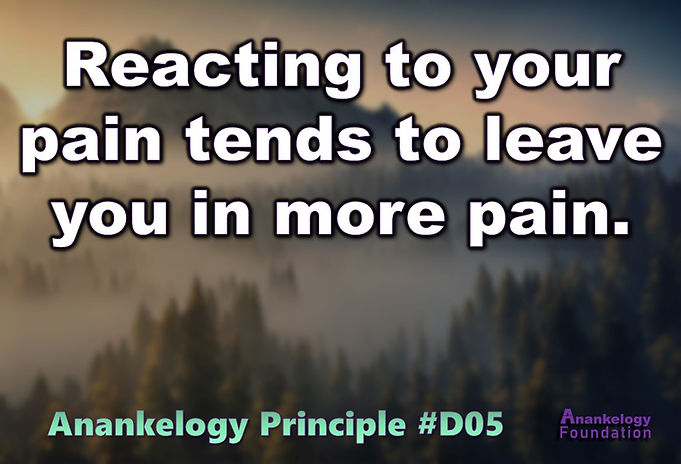
D05 Pain Principle
Reacting to your pain tends to leave you in more pain.
Image: Pixabay – jplenio (click on meme to see source image)
Summary
The more you try to avoid your pain, the more you end up ignoring the threats causing such pain. The more ignored, the more such threats persist to cause you more pain. The quicker you get to the source of your pain and remove the underlying threat causing you intense discomfort, the less pain you ultimately must suffer. There is no such thing as pain apart from unresolved needs.
Description
Which do you think is more likely?
The more you can get rid of your pain with meds or others means, the better your life will be.
OR
Unless you get to the source of your pain and remove the underlying threats, you will always suffer some form of pain.
Anankelogy
Since there is no such thing as pain apart from unresolved needs, reacting to the pain instead of responding to the underlying need tends to leave you in pain. The more you react to your pain, the more you tend to ignore the message of threat fueling that pain.
Every painful emotion poses some threat for you to process.
Reacting to the pain of such threats more than responding to the threats themselves promises to leave you in more of such painful emotions you perhaps would prefer to avoid.
1. Anger: Outside of some need to reject some apparent threat, you feel no anger. Suppressing your anger easily leaves in place what you perceive as unacceptable.
2. Fear: Outside of some need to handle something menacing, you feel no fear. Repressing your fear tends to allow what you cannot seem to handle to menace you even more.
3. Depression: Outside of some need to redirect your energies, you feel no depression. Ignoring the root of your depression can leave you with even less energy or focus.
4. Grief: Outside of some need to adjust your life to a deep loss, you feel no grief. Failing to make the meaningful adjustment can prolong your painful grief.
5. Jealousy: Outside of some need to enjoy what others enjoy, you feel no jealousy. Missing this opportunity to realize your impactful expectations can trap you in more jealousy.
You can find a list of twenty such emotional pain conditions in the NR101 program. This program aims to help you to better respond to the needs behind each painful emotion. Too many of us find ourselves trapped in our emotional pain.
The more you can resolve your need to remove the associated threat, the more your painful emotions naturally clear up. You can remove a lot of cause for pain by simply relating to the need that pain seeks to convey.
Yes, some pain may persist in some situations. Especially those situations beyond your control. That’s where need-response steps in. It seeks to root out causes of pain at multiple human levels.
Need-response
One of the most overlooked ways to reduce pain is to stop causing others to feel pain. As Brené Brown put in The Call to Courage, “It’s easier to cause pain than to feel pain.” Popular norms model this approach of shifting your pain onto others.
Our legal professions of politics and the courts encourages us to push our hurt onto others, instead of reaching our higher potential to endure discomfort to resolve all the underlying needs. Even counseling falls short by encouraging the individual to change to fit into an unhealthy society.
Need-response upends this intolerable norm for making others feel our own hurt. Instead of spreading pain or hate, it brings out more of our potential for peace and love.
Reactive Problem
Institutions of law (judiciary and politics especially) tends to react to pain. Instead of identifying and resolving each need prompting the pain, you get categorized as opposing the other side ostensibly causing you emotional pain.
Both a court battle and election battle offer pain-relief to the winning side. The losing side gets to keep their pain. Neither side fully removes their pain, since legal processes rarely address all of the needs involved in such conflicts.
These legal institutions serve as poor models for how to address our emotional pain. You could even say the provide a disastrous guide for how to resolve needs, reduce pain, and raise our potential.
Counseling can only take us so far at the individual level. We need something like need-response to unpack and remove all that emotional pain.
Responsive Solution
Need-response starts with the affected needs. You may find it much easier to respond to the need when stepping outside of the reactive norms avoiding your pain. Need-response raises the standard unfortunately built into the design of our legal systems.
There is no greater human authority than resolved needs. The more need-response enables you to resolve your needs along with the needs of others involved in a conflict, the less pain each side must suffer. Instead of avoiding discomfort, you collectively remove the cause of discomfort with the power of love. The NR201 program digs deeper into this underutilized love-centered approach.
Responding to your needs
How does this principle speak to your experience of needs? Post in our Engagement forum your thoughtful response to one of these:
How can I be sure I am responding to the need and not merely reacting to the pain.
If you only knew how much pain I suffer, you would realize why I must react to it like I do.
I once responded to the other’s need, instead of reacting to my pain, and had mixed results.
What if I stop reacting to the pain but others in the conflict take advantage of me?
Instead of selecting one of these, post your own engagement feedback about your experience with the subject of this principle. Remember the aim is to improve our responsiveness to each other’s needs, toward their full resolution. If you’re new at posting here, first check the guide below.
Engagement guide
Any visitor to the Engagement forum can view all posts. So do keep that in mind when posting. Sign up or sign in to comment on these posts and to create your own posts. Using this platform assumes you agree to our terms of use and privacy policy. Remember to keep the following in mind:
-
Quote the principle you are responding to, and its identifier letter & number. Let’s be specific.
-
Demonstrate need-responsiveness in your interactions here. Let’s respect each other.
-
Engage supportive feedback from others on this platform. Let’s grow together.
Together, let’s improve our need-responsiveness. Together, let’s spread some love.
.png)









